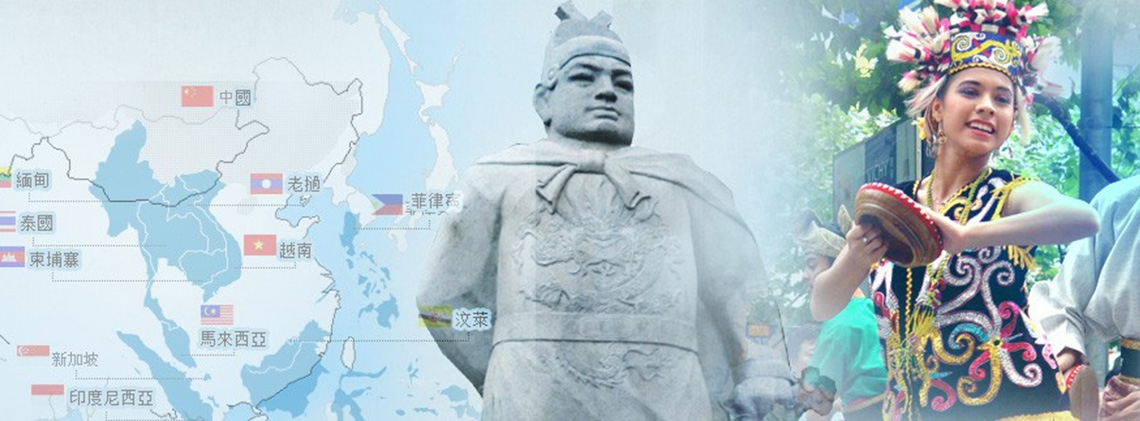
China’s Cultural Exchange with Southeast Asia
Splendid
Chi Culture
Topic
China’s Cultural Exchange with Southeast Asia
China and Southeast Asian countries have been in contact to varying degrees down through history, conducting exchanges that exerted profound mutual influence.
Exchanges between China and Malaysia can be traced back to the Han dynasty (206 BCE–220 CE). In subsequent dynasties, they maintained frequent economic, trade, and cultural exchanges. In the early Qing dynasty (mid-seventeenth century), the imperial court adopted a closed-door policy, but after the ban on maritime trade was lifted, active exchanges commenced again. During the Republic of China era (1912–1949), China and Malaysia fought shoulder to shoulder against Japanese invasion.
China was in contact with Indonesia as early as the Han dynasty. China’s ceramic trade opened the door to China-Indonesia exchanges; later, Buddhist cultural exchange between the Tang (618–907) court and Indonesia made a great contribution to promoting Buddhism. In the Ming dynasty (1368–1644), Emperor Chengzu (r. 1402–1424) further strengthened the development of overseas relations, and Indonesia was one of China’s tribute states.
The earliest contacts between China and Brunei started in the Tang dynasty. During the Song dynasty (960–1279), Brunei became the hub for China’s overseas transportation. Frequent exchanges of official and civilian fleets enabled trade to flourish between the two places. In the Ming dynasty, exchanges between China and Brunei grew even closer.
Contacts between China and Vietnam can be traced as far back as the Shang (ca. 1600–ca. 1100 BCE) and Zhou (ca. 1100–256 BCE) dynasties. Vietnam was influenced by Chinese Ruism (a.k.a. Confucianism). In addition, Buddhist cultural interchange between China and Vietnam was a vehicle of major exchanges. During the Ming dynasty, relations between China and Vietnam were even closer because of their wars with other countries. The modern civil war in modern Vietnam led to an antagonistic situation between the North and South, in relation to which China occupied an important position.
The earliest document of contacts between China and Laos was recorded in the sixth year of Huangwu (227) in the Wu state (222–280) of the Three States period (220–280), when the king of Tangming Kingdom dispatched envoys to the court. With the advent of the Tang dynasty, Wendan Kingdom dispatched envoys to the Tang court four times, and they were warmly received. In addition, titles were conferred upon them by Tang emperor. Links between China and Laos in terms of cultural origins can be verified by examining origin myths of the two ethnic groups.
Contacts between Cambodia and China were first established in the Eastern Han dynasty (25–220) and the Three States period. By the Southern Dynasties period (420–589), the two regimes had progressed to religious and cultural exchanges, and their arts and culture exerted mutual influence. “Funan music” was a ritual music and dance form with Buddhist coloring from the Funan kingdom (Khmer, Nokor Phnom). During the Three States period, Sun Quan (182–252, r. 229–252), the founder of the Wu state, established the “Funan Music Bureau.” The music was introduced to China at that time, and became popular in the Sui (581–618) and Tang courts.
As early as in the Western Han period (206 BCE–24 CE), Chinese ships made voyages to the Thailand area. Thailand’s Sukhothai kingdom (1238–1438) rose during the Song and Yuan (1271–1368) dynasties. The king sent envoys to China numerous times, and Sino-Thai diplomatic relations became quite close. In addition, émigré Chinese based in Thailand introduced Chinese medicine there, and features of Thai medicine were adopted by the Chinese. Thus, the pharmacopeia of Chinese medicine includes quite a few Southeast Asian spices.
Sino-Burmese contacts can be traced back to the fourth century BCE. At that time, the Silk Road in southern China was already open, and these two regimes began frequent exchanges. During the Song and Yuan dynasties, exchanges between the two places underwent an important transformation. Maritime routes were developed because land routes in northern China were blocked during the Song dynasty. Thus, the link between the Song dynasty and Burma was further strengthened. During the Ming and Qing dynasties, Zhu Yuanzhang (1328–1398, the founder of the Ming dynasty, known as Emperor Taizu, r. 1368–1398) sent envoys to Burma; their contacts were frequent, and maritime trade at that time also continued to develop.
During the Tang, Song, and Yuan dynasties, China and the Philippines had close cultural contacts, and trade was also substantial. In the Ming dynasty, the Philippine Islands established diplomatic relations with the Ming court. In 1565, most of the Philippine Islands became a Spanish colony. Only Sulu remained independent, and envoys were sent to China.



